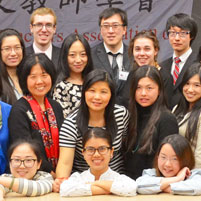Training PA’s Chinese Teachers
By Shilo Rea

Speaking Chinese in the United States is on the rise, with more than 2.6 million speakers in 2009 and a growing number of students interested in learning the language.
To promote quality Chinese education for students in western Pennsylvania, Carnegie Mellon University’s Sue-mei Wu founded and leads the Chinese Language Teachers Association of Western PA (CLTA-WPA). The non-profit organization works to help improve and strengthen Chinese language and culture instruction by providing teachers opportunities to exchange information, ideas, experiences and materials.
“We have several colleges and universities in the area, and many K-12 programs have been adding Chinese language programs,” said Wu, teaching professor of Chinese Studies in the Dietrich College’s Department of Modern Languages. “CLTA-WPA provides an opportunity for these language teaching professionals to network on a local level and meet more frequently and at lower cost than would be possible with national or international teaching organizations.”
Last month, Wu and her Modern Languages Department colleagues Gang Liu and Haixia Wang participated in the 2015 Chinese Pedagogy Workshop held by the University of Pittsburgh’s Confucius Institute. Throughout five days, 35 new teachers from China were trained and oriented to teaching in the U.S. The teachers will teach Chinese language and culture in PA K-12 and college level programs.
Wang, an adjunct professor of Chinese Studies, organized the workshop, which included lectures, presentations and other activities.
“The new teachers from China are usually unfamiliar with both the U.S. school setting and the learning culture of U.S. students,” Wu said. “In order to help them to deal with the various different learning situations and classroom practices that they may encounter, experienced U.S. educators share their observations and advice throughout the workshop to help the teachers know what to expect during their teaching in the US.”
Liu, assistant teaching professor of Chinese Studies, discussed the integration of cultural content with language teaching.
“Culture is always intertwined with language. Whether we want to admit it or not, to exclusively teach one without the other in a language classroom is almost impossible. Since we cannot separate them, we better find a way to integrate them. We have to understand that the true acquisition of new vocabulary, expressions and grammatical structures cannot do without the knowledge of the culture-specific meanings and social functions behind them,” Liu said.
He added, “At the same time, any cultural instruction in a language class will become purposeless and superficial if it is not made into an integrative part of language training. Students will benefit much more from learning them together, as an organic whole, than separately.”
To introduce how to integrate new technologies effectively into the classroom, Wu showcased her CMU Open Learning Initiative (OLI) Chinese project and Chinese language and culture learning modules. Wu’s research and experience in using technology-enhanced learning (TEL) methods is one example of how CMU researchers have spent decades advancing learning engineering in order to improve outcomes for their students – a hallmark of the university’s Simon Initiative.
“The OLI environment is great for students because it allows instructors to design and implement language learning activities and assessments that incorporate text, images, sound and video, providing students with lots of exposure to various language and culture elements and ample opportunity to practice them,” Wu said.
She also believes OLI’s ability to store data on how student interacts with the different elements of the course is invaluable.
“Instructors can quickly get a sense of how students are doing and what things might be causing trouble for them. Researchers, too, can use the data to figure out what types of learning activities are most effective for student learning,” she said.